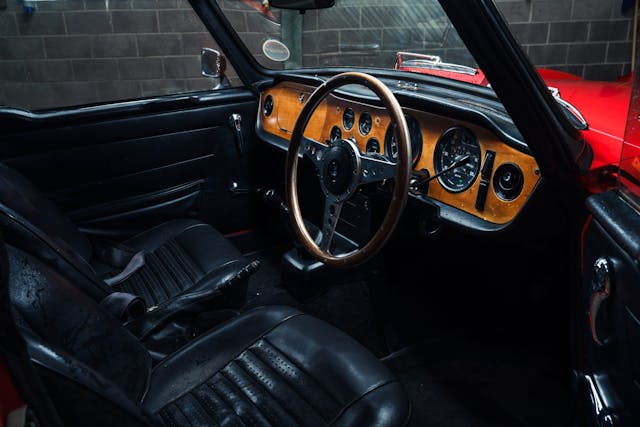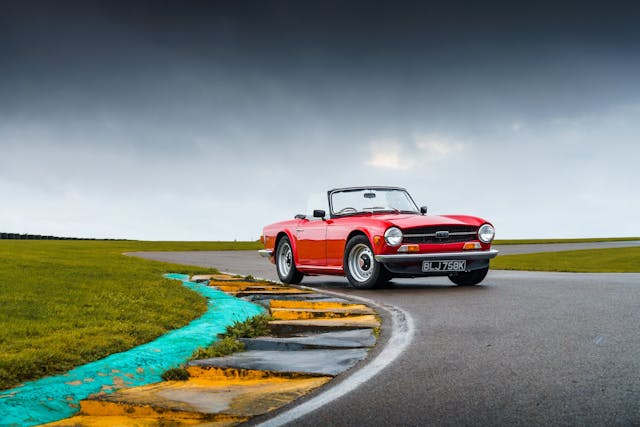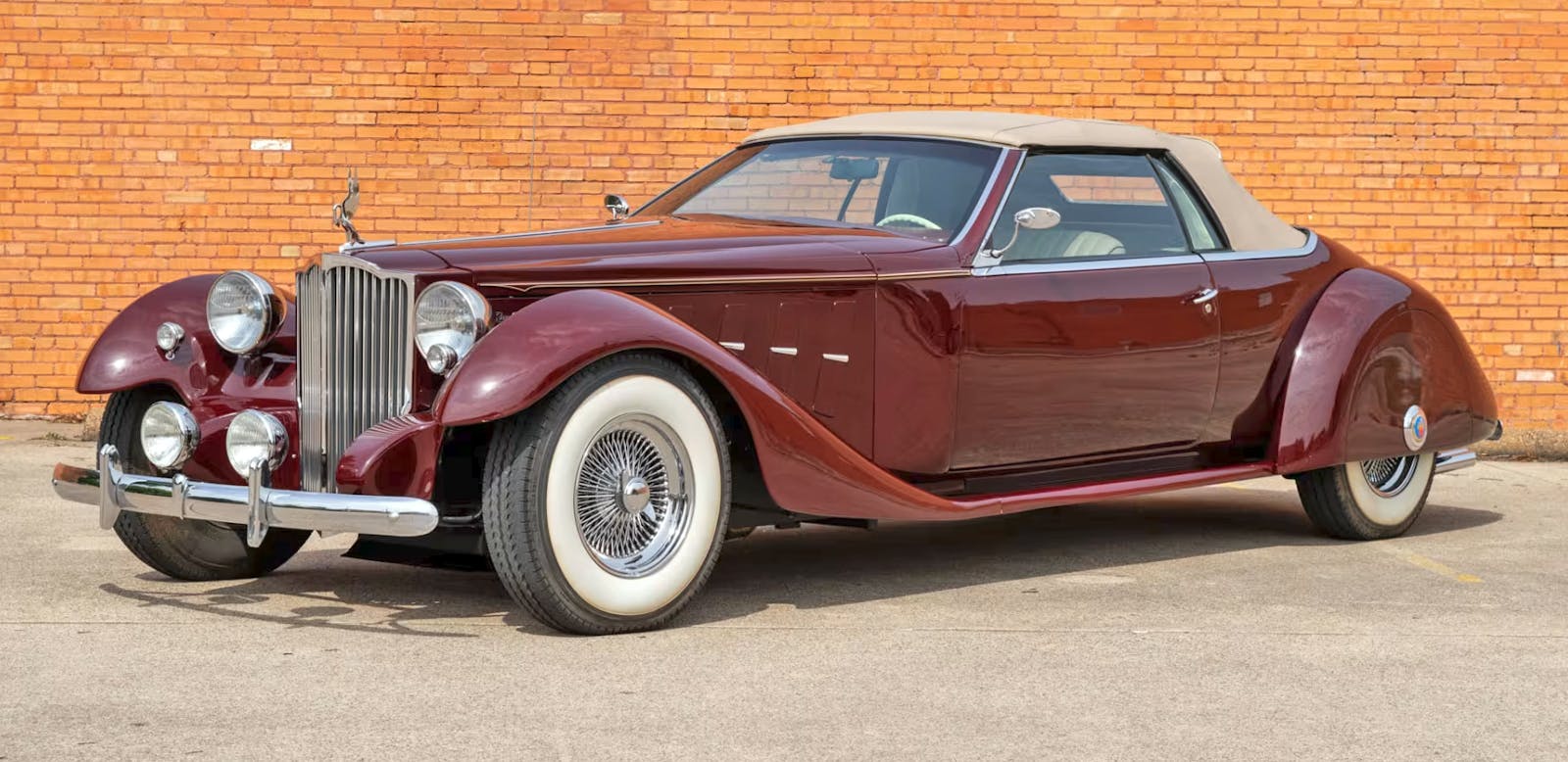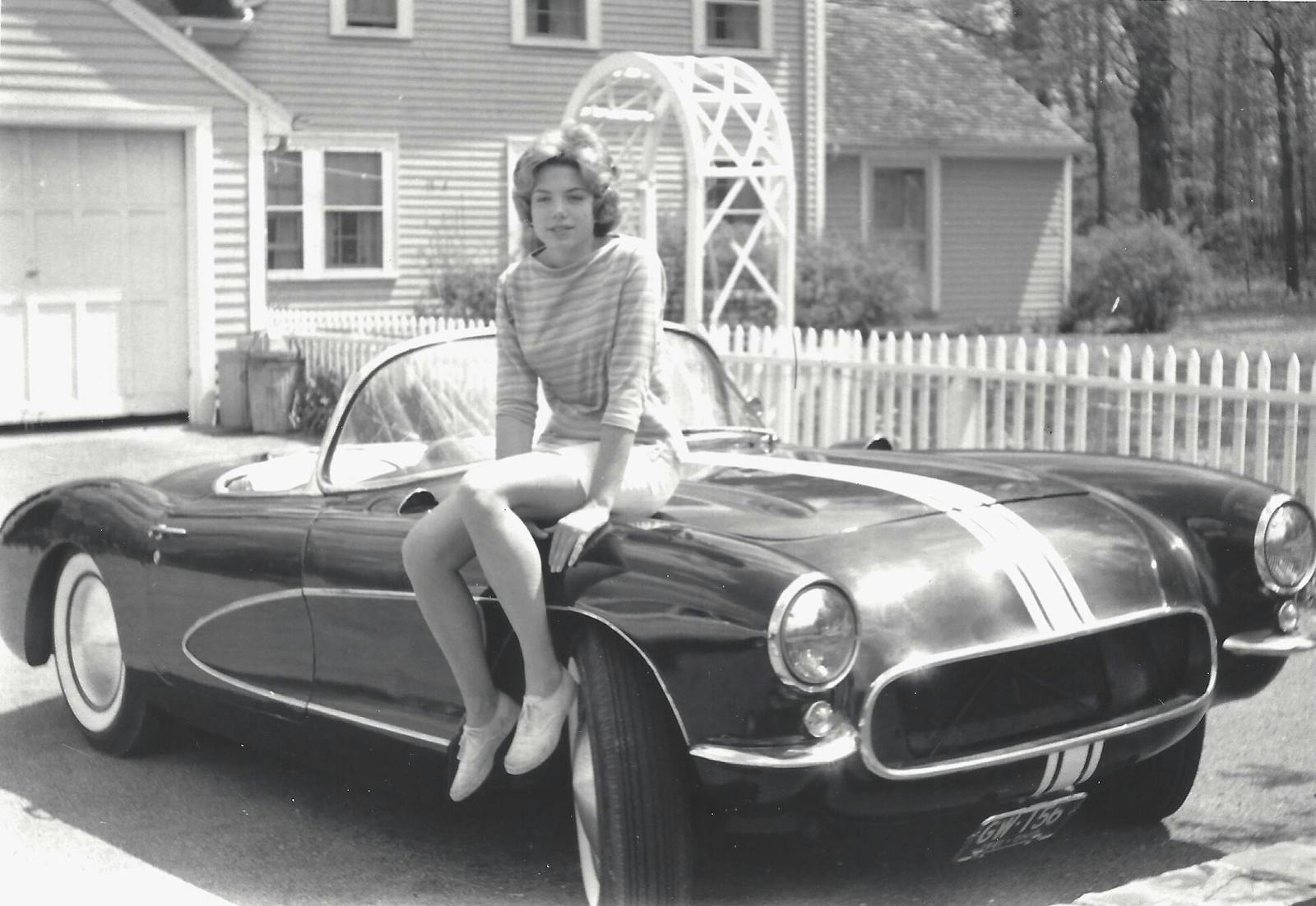In defense of the Triumph TR6

So, this would have been the early ’70s, ’73 maybe. I was just a teenager and hitching a ride was the way that impoverished youth got about in those days—no Uber for me. People would stop, too, since this was a more generous and tolerant age. I stuck my thumb out on the outskirts of Lymington in Hampshire and within minutes a vision in Damson Red drew up, top down, that “six” sounding like a jetliner at bay. I swooned.
“Jump in,” said the ex-military type behind the wheel. Sounds like a pick-up line, which I suppose it was, but not in that way. I think he just wanted to show off as we howled out of Pennington onto the Milford road and past Efford Horticultural Research Station, with the square-ended needle on the rev counter touching the 5750-rpm redline in overdrive third then fourth, with me barely noticing it was almost exactly the same gear ratio.
“I nearly drove my secretary’s Mini,” he boasted. “But I reckoned for another fiver on fuel it would be worth bringing the red peril out—after all, it’s a lovely day.”
Indeed it was, but I’ve often wondered about that conversation. Another fiver, hum. Given he was on his way to look at a house in Dorchester (he was an estate agent, of course he was), a round trip of about 100 miles and with fuel at about 35 pence a gallon, he’d have to be driving like an absolute nutter to find the difference between the big TR’s 25-mpg and the Mini’s 40-mpg to be another fiver. True, this was the full CP-prefix car with its fuel-injected six belting out 150 bhp (~148 hp), but I still reckoned the difference to be about a pound, which could still be had in note form. Perhaps he was on some sort of expenses fiddle … but good as his word he dropped me off in Milford on Sea and growled up the road. Wonderful.

There were many who thought that Karmann of Germany’s quick and cheap restyling job on the Michelotti styling of the TR5 was a brutalist monstrosity, but not me. You quickly tired of “hairy chested” as a descriptor of this last separate-chassis TR in road tests, and Spen King’s insistence on a larger-diameter front antiroll bar meant that the square-set two-seater would tend to understeer in extremes rather than the old TR5’s tendency to oversteer, but it looked and felt more modern, more in keeping with the times compared to the TR5 which could trace its looks to the 1961 TR4—although both TRs could trace their chassis lineage back to the TR2 of 1953.
Of course, this car was launched in 1969, the year George Lazenby got an outing as James Bond in a kilt and a cardie (along with Diana Rigg, surely the best-ever Bond girl) in On Her Majesty’s Secret Service. And you’d be forgiven for missing the launch of this reskinned Triumph sports car that year, what with Neil Armstrong and Buzz Aldrin landing on the moon, ad the Woodstock and Isle of Wight festivals taking place, which some think marked the end of the spiritual ’60s. On my way to buy David Bowie’s Space Oddity in Lymington High Street, I was told in agog tones about the two hippies who had come back from the Isle of Wight after seeing Bob Dylan, Free, and The Who, walked into the launderette, taken their clothes off, and sat there naked while the washing and drying cycle took place. Then there were the maiden flights of the Boeing 747 and Concorde, and the first ARPANET message, which marked the beginning of the internet on which you are reading this.

It was the best of times, certainly, but we were about to enter the worst of times. The world was about to be hit with the first oil-price shock of the early ’70s, which impacted the UK in the form of a devasting house-price slump, devalued wages, and what economists call “stagflation,” where even politicians’ folderol made no difference to the prosperity and wellbeing of the nation. Fripperies such as TR sports cars were the last thing on people’s minds, though in America, where the oil-price impact was less and folks struggled to keep their hands in their pockets, the TR6 did well.
How well? Now there’s a subject for debate. Turn to the expert Bill Piggott in his excellent originality guide, Triumph TR, and he sets out the background to the TR6, explaining that by 1968, despite the fuel-injected six-cylinder TR5 being the fastest ever TR, its Michelotti looks desperately required a facelift to appeal in a European sports car market which was fast being eroded by performance saloons, and for buyers in America who were restless for something new in the land where sports cars were still popular.
Extravagant spending on a niche sports car, however, is almost always hubristic, so budgets were super tight and there wasn’t a lot of time. In the end, it was Karmann the German coachbuilder who stepped up to deliver a radical new look which changed hardly anything fundamental. The chassis and inner structure, plus the suspension and drivetrain and interior, were largely unchanged, as were the doors and windscreen surround. With just new wings, bonnet, boot, front and rear panels, and external trim, the car delivered by the German firm was handsome and more modern-looking. It could be readied for production in less than a year, which meant the TR5/250 model, which was only on sale for just 15 months, became one of the rarest TRs, with a total of 2947 TR5s built and 8484 250 models.

This compares with the TR6, though you need some amateur detectoring to find the definitive totals, for there are some stupefying inaccuracies out there on the web. Derek Graham, the TR Register’s TR6 registrar, has the definitive numbers, as the figures are based on production ledgers for the TR6: there were 13,702 fuel-injected cars (including the 3600 completely knocked down “CKD” cars assembled in Belgium) and 78,147 carbureted cars which sold mainly in North America where emissions legislation ruled out the Lucas mechanical fuel injection and the high cost of the system could have priced the car uncompetitively.
About which we should come to, since the Lucas system is not, as some of the internet suggests, an unreliable, prone to overheating monstrosity. When well maintained it is a thing of loveliness, which imbues the TR with a terrific progressive surge of power, a steady idle, and few if any shortcomings. It’s a low-pressure (110 psi) system which is largely a fit-and-forget device, though it can suffer issues, mainly on hot days where under-bonnet temperatures can vaporize the fuel in delivery pipes and leave owners stranded. Few PI cars will not have been rebuilt or had serious work done by now, though as old hands know, that can be a curse as much as it can be a blessing.
So, what’s a TR6 like to drive? Rather lovely, that’s what. Powerful with a beguiling engine note, the TR6 was never short of performance and it’s hard not to play tunes on the overdrive. In 1969 Motor magazine achieved a maximum each-way average top speed of 117 mph, 0-to-60-mph in 8.5 sec, with an overall fuel consumption of 20.8 mpg and a “Touring” figure of 28 mpg.

“Smooth and potent,” the test concluded, “a nice blend of old he-man feel and up-to-date behaviour.”
Although the lead picture was of the hard-cornering TR6 with an inside front wheel in the air (in the wet!) the other shots showed the fantastic amount of chassis squat under power and the road tester struggling with the top fastening. In general, however, the magazine’s testers approved and considered the TR6 “probably the best value for money in open top terms.”
My experience in a friend’s mildly modified TR6 is of a powerful, well-balanced, and generally safe car with direct steering, and soft rear suspension to keep traction, but which also requires you to “flow” between bends to avoid upsetting the handling. With plenty of room, and a really good heater, this seemed like a brilliant grand touring car which could also be used for sprints and hillclimbs if the owner were so moved.
The question is, though, what were they like in period? Let’s turn the clock back to November 1973 when Clive Richardson, Motor Sport magazine’s redoubtable assistant editor (who died last June), gave his verdict on a year and 11,300 miles in his mimosa-yellow Triumph TR6. Perhaps we should have been forewarned about the tenor of the article when he revealed that his wife had nicknamed the car “Pig-in-‘ell” after its registration plate PGN769L. Despite Richardson’s enthusiasm and almost unbelievable optimism, he’d found himself in a truly awful “Friday-afternoon” car, which suffered leaks from hood and drivetrain, unreliability, screeching brakes, a misfiring engine, self-destructing tires, leaking Lucas fuel injection, rust on the bodyshell, and badly fitted and torn interior trim. As a spotty youth I couldn’t believe that a new car could be this bad, but I was to learn and Richardson’s fine piece, which can still be read on the Motor Sport archive, is an object lesson in just how things were at British Leyland in the ’70s.

Once things were largely sorted out by Triumph’s experimental engineering department, Richardson warmed to Pig-in-‘ell writing: “At one time I thought this TR6 would drive me up the wall, but over the last 5000 miles I have grown to love it. It has character, it has reasonable performance and that open-top potential, while I even enjoy the fairly primitive handling.”
Best not look back with too much rose tint on your glasses, then, but these days, with a wealth of helpful owners, excellent clubs such as the TR Register, and specialists who will modify your TR to go to the moon if you’ve got the desire (and the pockets), owning a TR6 is a lot easier, more fun, and hopefully involves you spending less time at the side of the road. Dare I say it, with ’70s revivals that seem to come and go, the old TR6—which was one of the 10 classics highlighted in the 2022 Hagerty UK Bull Market List—is now a cool car to be turning up in, which is something I never thought I’d be writing.

***
Check out the Hagerty Media homepage so you don’t miss a single story, or better yet, bookmark it. To get our best stories delivered right to your inbox, subscribe to our newsletters.


Austin Healey 3000 mark III much better car than TR6 , my Healey is much more reliable faster and much better looking
As one who raced a ’60 3000 on most of the midwest road courses and drove one on the streets back in the day, I would call hogwash. When new they were constantly in the shop and Lucas was at his finest. The backroom of the dealership who sponsored our team was always overflowing with warranty work. It is only through the years of restorations and pampering that they have become more reliable. 50 years later the TR6 is every bit as reliable. Yes, they were always faster but never more reliable. As for looks, that is always subjective.
Valid or at least defensible points, but it also costs about 3x the price of a TR6. I would argue the Healey isn’t that much better and the TR6 is a better deal. I have had a Healey 100 and currently have a TR250, love them both, but very different cars.
The one British roadster I’d really like to have! Good ones run too high for me as a hobby car. Sometimes I kick myself for passing up a really nice looking and driving example for $5K about 10-12 years ago. Beautifully done car, looked perfect! But someone had pulled the engine (blown original) and put a GM V6 and auto trans in it. I would have lived with the V6 for the price had they at least stuck a five speed behind it!
I’m the original owner of a 1973 TR6 with a hardtop and overdrive and I still clock two to four thousand miles a year on my 50 year old girl. I live in the country now and drive the same curvy backroads I sought out when I was 21 years old in 1973. Driving a TR6 never gets old and is just as much fun now as it was in my youth. A hardtop tightens the car and there is less flex around curves which adds to the smiles per gallon. The Laycock J type overdrive makes highway driving a pleasure at 2900 rpms at 70 mph. Property maintained, the TR6 is very reliable and electrical issues are nonexistent. Great car, great fun.
Got my 74 in 76. Frame was already very rusty. Rear frame is in poor condition. Replace faulty BLMC water control valve with teflon Rambler valve of almost the same threads. End that problem. Cut out all electrical clips on harness and soldered. End that problem. Went to high compression, mod carbs, racing pushrods and springs, Kastner S2 cam. Bought BLMC hard top for $400. Really sharp. Hired a fool to install J overdrive who destroyed the trans. My desires are a BMW 6(turbo), and a 5 speed and a real IRS. Have to finish my 70 Eldorado and 86 9000 T first. And a couple of motorcycles. May live long enough. Still looks good though.
One of my best friends had one out of High school. That car just pure fun!
I have liked these since I was about 15 (1970), and still do. Probably won’t ever own one, though – sadly. A friend had one back about 1974, and drove it in the Midwest winter, snow and all; he put chains on it, and it seemed to go fine.
My wife bought her TR6 off the showroom floor in 1975. It has followed us from Indiana to Washington to Alaska back to Indiana, down to Florida and now back to Indiana. It has had one frame off restoration. There were two serious modifications; 1) strip out the wiring and replace it with modern relays, fuses, sockets and real automotive grade wiring. The original switches are in place. And, 2) to replace the wheels/tires with a 16″ Panasport style wheel that IMO fills the wheel arch better than the stock wheels/tires. Really need to do something with the headlights but have yet to find the right look. The car has never failed us mechanically. And, it is still her baby. I used to get to “test” drive it after servicing or whatnot but after fracturing four vertebrae and two failed surgeries, I cannot get out of the car with out a crane!
I had a 1967 TR-4A and love it. After owning it for 9 years, sold it because my son was to big to sit behind
me. The man that purchased it for his son, blew the clutch after owning it for a month. Sad.
There were 8484 TR250s built and about 3000 TR5s. I think author has his numbers confused
Thank you for the correction, we are making the change now.
Donnie Stokes was head of British Leyland from 1968 to 1975. Alex Park 1975-1977. Mikey Edwardes took over in 1977 and retired in 1982. To them and all that followed, congratulations for turning some of the nicest and most interesting looking vehicles in history into money pits for their owners to the tune of billions over the years in repairs. At least with the MINI, now it is Germany who continues the miserable quality record of the UK and gets to preside over a vast transference of wealth upwards from MINI owners to BMW stockholders and parts manufacturers. The UK auto industry was a beautiful thing destroyed by its incompetent upper management.
folks, what we have here is a USDA Grade A British Leyland kit car-level POS;
i’m speaking from direct experience having owned one (quite a letdown from my previous E-type even with its water jackets constantly leaking and contributing to warping the head);
the body panels could be flexed with either hand and were absolutely useless in holding the rear suspension mounts which would sag in if you looked at them when the panel they were mounted to gave way;
i could go on but you get the point..stay away from British Leyland kit cars;
I’m on my way to the Buick dealership to buy a brand new TR-6 (yep, they were a Leyland dealer as well). There she was, dark blue, saddle interior, redline tires and I’m ready to pull the trigger on this beauty until I see brand new red, “shape of things to come” TR-7. I bought the 7 and to this day I regret not buying the 6. Within 6 months my “shape of things to come” car turned into my “shape of a disaster that has arrived”.
First car I loved but had to convince parents to buy, ’62 Austin Healey Sprite. I learned a lot about maintaining vehicle systems on it but worth it. Second was ’68 MG Midget, loved it but got broadside, no issues till then. Replaced with a ’68 Triumph GT-6, loved it most. Love GTs. Really good vehicles all. Later first wife had several VW bugs, each had engine leaks and rebuilds. My dad didn’t know much about vehicles mechanics so I learned by doing. Still love sports cars but almost 70 so maybe hard to get up and down, or work under dash head low feet over seats.